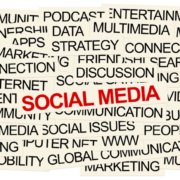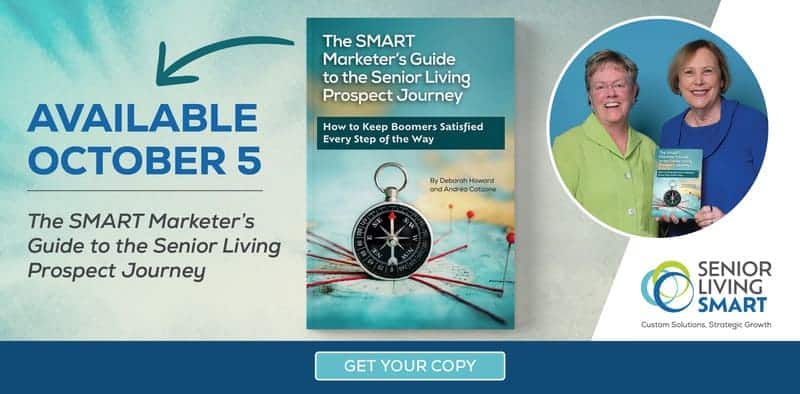Senior Living Social Media Marketing: 4 Reasons to Invest
We’re getting ready to unleash a series of blog posts on senior living social media marketing. First up, why should you invest in social media anyway? Here are four good reasons.
1. Your prospective buyers are already hanging out on social media.
Social media use has skyrocketed among all demographics, including older adults. According to Tech.co, among people 55+, there’s been a 66% increase in product discovery via social media over the past four years, and 70% have bought something online in the last month.
Here’s the breakdown for social media usage among U.S. Baby Boomers. (Source: Statista.)
- YouTube – 70%
- Facebook – 68%
- Pinterest – 27%
- LinkedIn – 24%
- Instagram – 23%
- Twitter – 17%
Bottom line: Your prospects are already spending ample time on social media. So why not meet them where they are? This is why senior living communities need a strong overall digital presence. Having a great website is important, but it’s not enough. Your brand needs to extend to social media as well.
2. Solid ROI is possible, provided your social media marketing is done right.
Too often, communities take a willy-nilly approach with their senior living social media. They might post occasionally to Facebook. Or maybe they start an Instagram page, only to abandon it after a few months. Or maybe the marketing team is posting the same things across ALL channels, thus giving themselves (and only themselves) the appearance that the community is “active” on social media.
None of this is strategic. And none of this is smart. None of this is going to give you a good return on investment (ROI).
Remember, senior living social media ROI doesn’t magically happen. Like everything else in marketing, you need to have a smart strategy to achieve the ROI you’re looking for.
In addition to strategy, you also need a way to measure your results. This will absolutely require robust analytics and a senior living website that’s built to convert visitors into leads—along with marketing automation to nurture those leads.
By the way, if you’re wondering what we mean by ROI, we’re typically talking two big things when it comes to senior living social media marketing:
- Lead generation
- Brand awareness
And keep in mind that ROI opportunities exist within both paid and organic social media.
You likely understand how paid social media advertising can result in ROI. But people sometimes forget that ROI applies to organic social media as well. It takes time and people to do the work that can deliver strong organic results (and those hours and people cost money!).
3. Senior living social media channels provide a great way to share your community’s “essence.”
Your senior living website is a great place for information, both factual (e.g., locations, amenities, floor plans, price ranges) and educational (e.g., “10 tips for financing senior living”). All of this is essential and important info for your prospective buyers to have. However, as we often acknowledge, so many senior living websites sound the same because they’re all essentially selling the same basic “product.”
Social media provides the perfect place to elevate your community and share its true essence. Post a shot of a resident enjoying a cup of coffee on a summer morning as she sits on her patio marveling at the view. The way the sun spills onto the patio, the smile on her face, the view itself—this is REAL. It’s not posed. It’s not a stock image. It can help a prospective buyer picture what their morning might be like waking up with a cup of coffee in your community.
4. Content for social media channels can be easier and less stressful to create than traditional marketing materials.
People expect your website and printed sales collateral to be slick and polished. But with social media, people crave authenticity. While some might feel overwhelmed by this, we think that the casual nature makes it easier to create content, not harder.
Strike a truly conversational tone in posts, captions, and comments. Sound like a real person. Talk about real, relevant things in an honest way. Have fun with emojis. Be playful in your tone. If you make a typo, don’t sweat it.
Take pics with your phone (they don’t need to be perfect). In fact, you’ll be rewarded for more authentic shots. This makes it easier for more people to participate beyond your marketing and sales teams. Anyone with a phone has the ability to capture something special that you can share.
For example, that fabulous shot we described above of the resident enjoying a cup of coffee? You can share it across multiple channels. Sure, you should resize the image according to the platform’s specs. And you will need to tweak the description/caption, depending on where you’re posting it. But still—you get more mileage from that one shot.
Repurpose content across channels (but do so thoughtfully). Keep in mind that repurposing content doesn’t mean simply copying, pasting, and sharing it across five different channels. Instead, be thoughtful in your approach. Where should you use that one awesome shot you took of a resident enjoying coffee? The shot is great for Facebook and Instagram, but probably less so for LinkedIn since LI focuses on professional networking.
Still feeling overwhelmed? Don’t go it alone! Turn to experts in social media and senior living. (That would be us!)
Thanks to our decades of experience working in senior living, we understand what prospects crave. And as digital marketers, we get social media as well. We can bring it all together and deliver the results you’ve been looking for. Let’s chat!









